Sergio Ruzzier's Blog, page 20
October 24, 2010
Emily Jenkins' Picture Book List
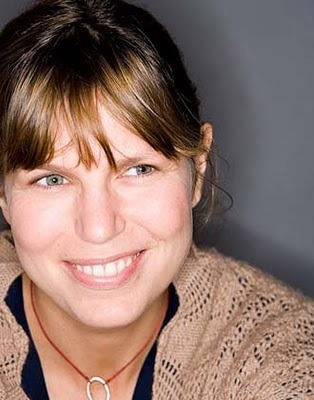 Portrait by Heather Weston
Portrait by Heather Weston Emily Jenkins is the author of Love You When You Whine , illustrated by Sergio Ruzzier (me!), plus other picture books including Skunkdog, That New Animal, both illustrated by Pierre Pratt, What Happens on Wednesdays, illustrated by Lauren Castillo, and The Little Bit Scary People, with pictures by Alexandra Boiger. She won two Boston Globe/Horn Book honors for picture book writing and also wrote Toys Go Out and Toy Dance Party, both for middle-grade readers, illustrated by Paul O. Zelinsky. I do hope to work with Emily again soon.
Let's see what are ten of her favorite picture books:
Here is my own list, though it's a bit off-the-cuff. I'm so glad you asked me, as it made me think about what I value in picture books.
1. A VERY SPECIAL HOUSE by Ruth Krauss, illustrated by Maurice Sendak. This book has such amazing rhythms and it's like a window into the mind of a child. She was just a phenomenal writer.
2. A GLORIOUS DAY by Amy Schwartz. I think Schwartz is the best picture book writer working today. This is maybe my favorite, but I also love What James Liked Best and A Teeny Tiny Baby. I love them all, actually. A Glorious Day follows the kids in a single, small apartment building through their day. It is an ordinary day -- but glorious. She has such an ear for truth and humor in small things.
3. MEET WILD BOARS by Meg Rosoff, illustrated by Sophie Blackall. This just makes me laugh. Those boars are so wonderfully horrible. I would love to be able to think up something like this book.
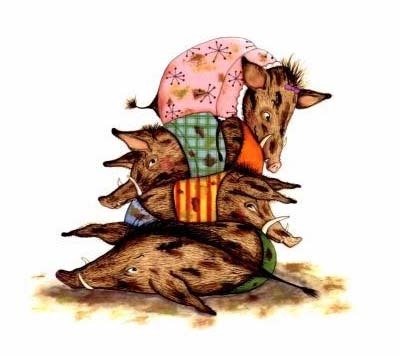
4. TRACTION MAN IS HERE! By Mini Grey. She is operating at so many different levels here. And it just makes me happy. "Traction Man is guarding some toast." I love that he figures out how to deal with his horrid knitted green romper by unraveling it into a tight little bathing suit. Joy!
5. MR. GUMPY'S OUTING by John Burningham. Mr. G invites all these creatures to ride on his boat if only they don't behave as their natures dictate they should. The children mustn't squabble, the pig mustn't muck about, etc. And in the end, they all collapse and do what they mustn't; they capsize the boat - and he invites everyone back for tea and says they should come again. It's just true, about people and their foibles, and none of the foibles mattering in the end.
6. WE'RE GOING ON A BEAR HUNT by Michael Rosen, illus. by Helen Oxenbury. It's an old finger-play game, masterfully retold. I see something new in Oxenbury's illustrations every time I've read it. The family is so connected, the bear so menacing yet so lonely, the dog so loyal and yet skeptical.
7. FIRST TOMATO by Rosemary Wells. This one chokes me up every time, with so little ammunition. A bunny has a bad day, and envisions an alternate reality where her mother sends her to to see if any tomatoes are ripe. There's only one ripe one, and she wants to eat it -- but abstains, and brings it home as she was asked to do. Later, her mother serves her "first tomato soup, because I love you so."
8. BLUEBERRIES FOR SAL by Robert McCloskey. This book makes you notice things. It makes you pay attention. To words, rhythms, sounds, life.
9. THE SNOWY DAY by Ezra Jack Keats. It is just a perfect book.
10. SEVENTEEN THINGS I'M NOT ALLOWED TO DO ANYMORE, by Jenny Offill, illustrated by Nancy Carpenter. This, like Meet Wild Boars, is a naughty book. Like A Very Special House and Traction Man, it is a look into the mind of a child that is not at all what other people wish the mind of a child to be. I love it. And Nancy Carpenter pulls out all the stops here. The illustrations as hilarious and incredibly inventive.
Oh dear. I have left off so many, many books that I love.
Published on October 24, 2010 12:54
Marc Tyler Nobleman's Picture Book List

Marc Tyler Nobleman is the author of more than seventy books for kids, including the picture book Boys of Steel: The Creators of Superman , illustrated by Ross MacDonald. He is also a cartoonist, even though he admits he doesn't know how to draw Sponge Bob. He has a blog where he writes the stories behind the stories he writes.
Here's Marc's entry:
I love lists and I love picture books (natch) but I know I'm leaving out many favorites with this list, plus ask me again next week and it may be different:
(in no order)
- WHERE THE WILD THINGS ARE by Maurice Sendak
- THE CAT IN THE HAT by Dr. Seuss
- THE STORY OF FERDINAND by Munro Leaf and Robert Lawson

- THE MILKMAN by Carol Foskett Cordsen and Douglas B. Jones
- THREE LITTLE GHOSTIES by Pippa Googhart and Anna Laura Cantone
- THE DAY-GLO BROTHERS by Chris Barton and Tony Persiani
- THE MAN WHO WALKED BETWEEN THE TOWERS by Mordicai Gernstein
- MADELINE by Ludwig Bemelmans
- ALEXANDER AND THE TERRIBLE, HORRIBLE, NO GOOD, VERY BAD DAY by Judith Viorst and Ray Cruz
- MOOSE by Michael Foreman
Published on October 24, 2010 12:19
October 22, 2010
Matthew Cordell's Picture Book List
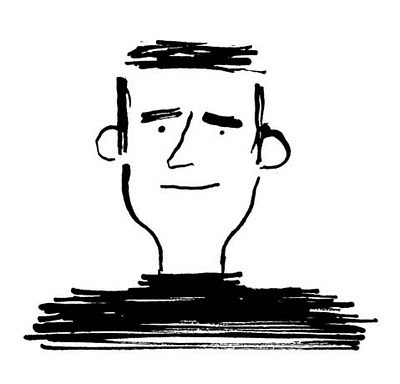 Matthew Cordell seen by Matthew Cordell
Matthew Cordell seen by Matthew CordellMatthew Cordell is the children's book illustrator of such titles as Toby and the Snowflakes by Julie Halpern, Mighty Casey by James Preller, Toot Toot Zoom! by Phyllis Root, and Justin Case: School, Drool, and Other Daily Disasters by Rachel Vail. Matthew is the author and illustrator of Trouble Gum.
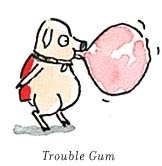 He lives in the suburbs of Chicago with his wife, author Julie Halpern, their daughter Romy, and a very sturdy cat named Tobin. You can see his work on his website and his blog. He was the first one to send me his list with ten of his favorite picture books.
He lives in the suburbs of Chicago with his wife, author Julie Halpern, their daughter Romy, and a very sturdy cat named Tobin. You can see his work on his website and his blog. He was the first one to send me his list with ten of his favorite picture books.Take a look at his website and blog.
Here's Matthew's list:
1. GORKY RISES by William Steig. This one is probably one of my three favorite Steig picture books, including SYLVESTER AND THE MAGIC PEBBLE (of course) and AMOS AND BORIS. I choose GORKY for my top ten because I'm a sucker for a boy (frog) who can fly book.
2. GRANPA by John Burningham. John Burningham is so freaking good. I love his humor and his grace and his fearless, fearless art. GRANPA is so much of that.
3. MOUSE TALES by Arnold Lobel. I do love Arnold Lobel and this book is brilliant. But to be fair, I lift this favorite from my wife's list of favorite pic books. I wouldn't know a thing about picture books if it weren't for her. And I'm so glad she shared this one with me.
 4. THE ENEMY by Davide Cali, illustrated by Serge Bloch. I only recently came upon this one. I suppose it's written for the older set because it's about war and peace. I love it. Serge Bloch is one of my big faves.
4. THE ENEMY by Davide Cali, illustrated by Serge Bloch. I only recently came upon this one. I suppose it's written for the older set because it's about war and peace. I love it. Serge Bloch is one of my big faves.5. WHAT DO PEOPLE DO ALL DAY? by Richard Scarry. This is one I can remember digging as a kid. So much detail and so much animal craziness going on. What's not to love? I'm still in awe.
6. LEAVES by David Ezra Stein. I like D.E.S. I like how each of his books is different from the last. And he always keeps it loose and fresh, which I really admire. I really like this one. I like his line and washes and I like the innocence and sweetness and enthusiasm of that bear.
7. MOON MAN by Tomi Ungerer. This is another fairly recent find for me. Super stylish and cool groovy vibe. I especially like the soldiers, weird scientist, and all that black.
8. MARTIN PEBBLE by Jean-Jacques Sempé. J.J. Sempé is one of my all time favorites for pen/ink. I also love his sense of humor and storytelling. His art in this book is super loose and sparse and very limited in color. I love it all. Beautifully designed.
9. MADELINE by Ludwig Bemelmans. Very cool and romantic and timeless and actually kind of strange. LB's art is amazing, of course. I also like how it goes from full color to limited color illustrations. I assume this was done to save money in printing the original edition, but it works really well in design.
10. WHERE THE WILD THINGS ARE by Maurice Sendak. I can't imagine leaving this off. I probably take it for granted a lot. Every now and again I like to pull it down and have another look. Never disappointed. <ilayer src="http://www.mail2web.com/cgi-bin/banne... href="http://myhosting.com/" target="_blank"><img src="http://www.mail2web.com/images/banner..." width="160" height="600" align="top" border="0" alt="" /></a></ilayer>
Published on October 22, 2010 13:06
October 21, 2010
Toad's List
I'm very glad to say that many people have already sent me their Picture Book Lists, which I will start posting in the next few days. Please keep sending!
But today I wanted to share with the world, or part of it, a recent acquisition: an Arnold Lobel's original and signed pencil drawing of Frog and Toad. It shows Toad loosing the list with the things he was supposed to do that day, from the "List" episode from Frog and Toad Together.
Arnold Lobel is one of my very favorite authors, and I still can't believe I was able to get this.
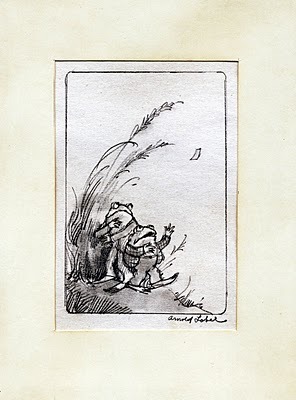

But today I wanted to share with the world, or part of it, a recent acquisition: an Arnold Lobel's original and signed pencil drawing of Frog and Toad. It shows Toad loosing the list with the things he was supposed to do that day, from the "List" episode from Frog and Toad Together.
Arnold Lobel is one of my very favorite authors, and I still can't believe I was able to get this.

Published on October 21, 2010 08:15
October 20, 2010
Picture Book Lists
I'd like to invite anyone who loves picture books to send me a list with ten of their favorite picture books, for kids or not. The books can be from any time and any country. I'd like to keep the definition of picture book as wide as possible. For example, one of my books will probably be William Steig's The Agony in the Kindergarten, which was a collection one-liners illustrated in black&white, about but not necessarily for kids.
You can be an author, an illustrator, an editor, an art director, a bookseller, a librarian, an agent, or anyone who has a passion for picture books.
Please send me your list with, if you want, a mini-bio, a picture of you, and a link that I can add to the post. Send to sergio(at)ruzzier(dot)com
Thank you!
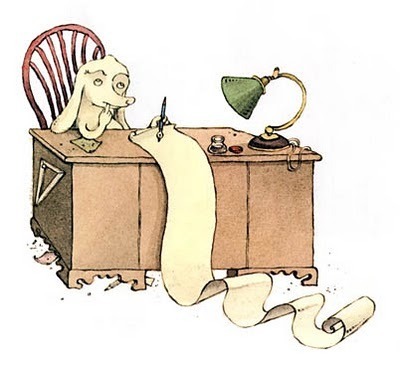 Amandina
Amandina

You can be an author, an illustrator, an editor, an art director, a bookseller, a librarian, an agent, or anyone who has a passion for picture books.
Please send me your list with, if you want, a mini-bio, a picture of you, and a link that I can add to the post. Send to sergio(at)ruzzier(dot)com
Thank you!
 Amandina
Amandina
Published on October 20, 2010 13:02
Original Art Show
Tomorrow evening the Society of Illustrators in New York City will host the reception for the opening of the Original Art Show, with some of the best (according to this year's jury) picture book illustration of this past year.
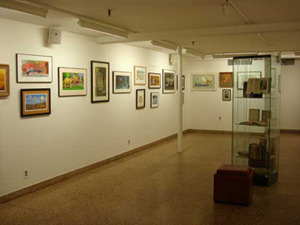 Photograph from the Society's website.
Photograph from the Society's website.
I was one of the judges and, coincidentally, one of my books was selected. Ah-hem.
Here's the drawing I chose to be in the show, the cat spread from Hey, Rabbit!
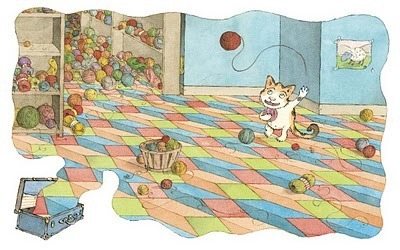

 Photograph from the Society's website.
Photograph from the Society's website.I was one of the judges and, coincidentally, one of my books was selected. Ah-hem.
Here's the drawing I chose to be in the show, the cat spread from Hey, Rabbit!

Published on October 20, 2010 10:02
October 6, 2010
A conversation with Caron Lee Cohen, author of Broom, Zoom!
Illustrators don't necessarily get to know the authors of the books they work on. I consider myself very lucky, then, to have met or even befriend most of the writers I have collaborated with: Karla Kuskin, Emily Jenkins, Lore Segal...
A few months ago, after illustrating Caron Lee Cohen's Broom, Zoom!, Caron kindly came to one of my Hey, Rabbit! signings in Brooklyn and we have become friends since. Caron is the author of a bunch of picture books and easy readers, including How Many Fish? and Three Yellow Dogs, this last one illustrated by the great Peter Sís.
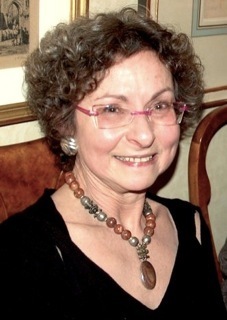 Caron Lee Cohen
Caron Lee Cohen
Recently, Caron and I have had an email exchange in which we shared thoughts about Broom, Zoom!, bare landscapes, and other things. I'm posting it here hoping that others will also find it interesting and entertaining.
Here it goes:
Sergio
In one of our first email exchanges, you told me: "I was astonished that the characters live on a bare cliff, a perfect match for an interior landscape of my own! I have a book where outlaw-dogs live on a bare cliff - in Death Valley."
Bare landscapes and cliffs (and empty interiors as well) are always been present in my drawings, since I was a kid. I guess that this fascination comes from different places, and I can name a few: 14th and 15th Century Italian paintings, like that beautiful Saint Anthony by the Maestro dell'Osservanza now at the Metropolitan Museum in New York;
old comic strips, especially George Herriman's Krazy Kat and Elzie C. Segar's Popeye; a movie by Pier Paolo Pasolini, "Uccellacci e Uccellini" ("The Hawks and the Sparrows"), which I saw when I was 7 or 8 years old. And also the neighborhood where I grew up, in Milan in the '60s and '70s, which at the time was at the edge of the city, with many empty lots, where herds of sheep would still walk by a couple of times a year. Or maybe it's just easier to draw empty landscapes, and not worry about buildings, forests, roads...
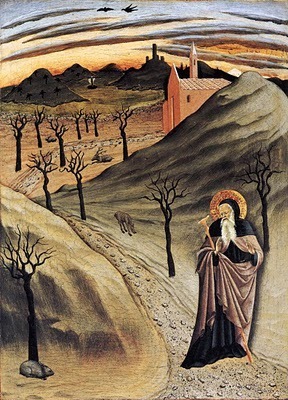 Maestro dell'Osservanza
Maestro dell'Osservanza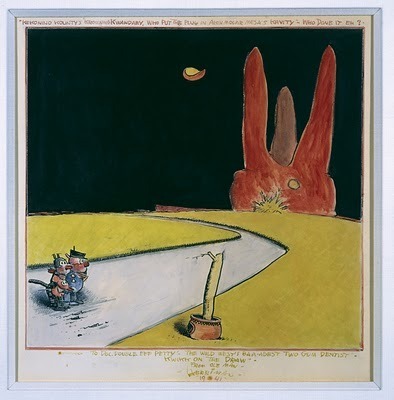 George Herriman
George Herriman
Can you tell me more about that "interior landscape of your own"? What was the Death Valley book?
Caron
I'll get to those questions, but those rich influences that shaped your fascination with bare landscapes are worth a closer look. So I was delighted to get your e-mail with a few images of what you'd mentioned. They blew me away!
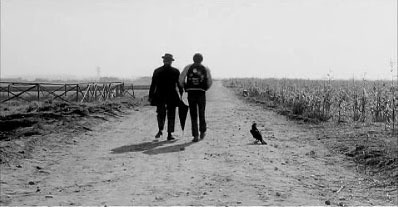 Pier Paolo Pasolini, Uccellacci e Uccellini
Pier Paolo Pasolini, Uccellacci e Uccellini
The image from The Hawks and the Sparrows - of a father and son conversing with a black crow while journeying on a road that goes endlessly into the distance - is potent and hypnotizing. In the Saint Anthony painting, the richly robed saint and the spooky bare trees create a haunting scene. And the Krazy Kat comic image with spindly cliffs bursting out of a flat landscape and a two-tone moon, makes a zany picture. A painting, a film and a cartoon, spanning 500 years, and so enormously different! But after much looking, I was struck by similarities. All three have roads that wind around from the foreground to the background. And on these roads are characters who all happen to be directing their attention sideways! That's gotta be a fluky resemblance. But another resemblance isn't a fluke. In each of these, I see unexpected, or out of the ordinary elements, fantasy elements - like the unreal trees along the road where Saint Anthony walks. The trees gripped me while I wondered, pleasantly perplexed, what they were about. The fantasy elements in all of these have a lot to do with the spell they cast on me. The three images provoke thought and emotion - enough to make lasting impressions.
A couple of lasting impressions that found their way into a book of mine, are nowhere near as fascinating as Renaissance art. My 50's childhood--after the fairy tales--was loaded with cartoons (Popeye was my fave!) where characters routinely fall off cliffs and spring back alive, and Westerns where landscapes are bare and desert-like, with hills, canyons and rolling tumbleweed. A few decades later I got going on the bare cliff book, Bronco Dogs, the story of cartoonish outlaw dogs in the old-time West. They needed a hideout. I looked on a map. There was Death Valley! And Comma-Ti-Yi-Yippi-Yippi-Yea Peak was born - a sizzling cliff in a terrain so perilous, no critter alive would chase them there. It's the only home the dogs have, but the cliff is a seesaw - the downside, is falling off of it; the upside, is sleeping under the stars. This landscape with its multitude of trials, fits them like a glove. It fulfills their needs for better or for worse. I always grow fond of my characters. I adore them. In this case the dogs and their landscape are inextricably linked: I adore the cliff too. It has a place in my imagination. In that e-mail, I called it an interior landscape of my own. And what a surprise when I saw the cliff landscape in Broom, Zoom!
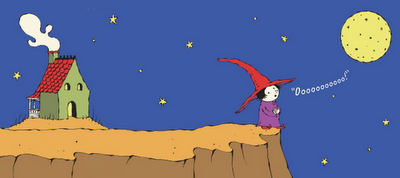 Broom, Zoom!
Broom, Zoom!
By the way, the broom in the book: I have the same one at home. I've had it for 35 years. I've never checked to see if it flies.
Do you feel fondness, or maybe you'd use another word, for projects you work on? You've said you enjoyed working on Broom, Zoom! very much. Are there any particular reasons you can mention?
Sergio
Well, the text was so perfect and minimal, that I felt absolutely free to give my own, personal interpretation. Even in the creation of the characters, I knew that I could do whatever I wanted, because there was no clear description of how they were supposed to look like. That's always a blessing for an illustrator, or at least for me. I felt fondness for them right away, after reading your words, even before drawing the first sketches.
Caron
It's wonderful to hear you say that! About feeling free because of the text. That's absolutely how I felt when I saw the art.
You sent me on a journey as a result of your questions; and in the process, I've given quite a bit of thought to the art in Broom, Zoom! And now, another surprise! I see substantial differences in our cliffs. My story is a fantasy with talking dogs, cows and ghosts. But Comma-Ti-Yi-Yippi-Yippi-Yea Peak is somewhere near Badwater in the sink of the Amargosa River, surrounded by volcanic craters, then hills and canyons, and finally salt flats on the fringe of Death Valley. That's the real terrain. That fantasy cliff seems pretty conventional at the moment, while the cliff in Broom, Zoom! is completely unconventional, creative and original. You've brought elements together in an unexpected way. And what would be expected, is omitted. Little Witch and Little Monster live in a world with no grocery stores, no chairs, no table . . . no one else. There's a broom, because they need it. There's a sky, because they fly it. There's no road, because they don't need one. This art is not limited by any real-world givens. Little Witch and Little Monster don't have the pressures of a technologically complex and hectic world. They won't grow up too fast on this cliff. As a writer I rejoiced at seeing this, because their world is pure. You've made them sweet and lovable. They are beautifully naive, free to develop from their own good natures. I'd enjoy exploring how their sweet natures would play out. Like the images you sent, where fantasy increased my interest - the world in Broom, Zoom! works magic, drawing me in and charming me. Unlike those images, where the fantasy can be jarring - in Broom, Zoom! the unexpected comes into the world seamlessly! The result is whimsical and dear.
Your art for the book is almost exclusively bare. So where it isn't bare, draws my attention and makes me wonder. The house has striking features--a back porch, smoke from the chimney and more. It hints at being alive! Can you tell me why you've developed the house in particular?
Sergio
As I was reading your manuscript for the first time, I knew I wanted the house to be looking like a witch house, but small and gentle. It's a childish haunted house, the same way the witch and the monster are little kids. Maybe when the three grow up they'll be scary and threatening, who knows, but for now they're just sweet and innocent.
I think it's interesting to see how such a small house can have a potentially never-ending inside, with huge rooms and no ceilings in sight.
One of the good things of doing this kind of drawings is that you can take so many poetic licenses. You can create worlds with their own rules. It's the same thing with writing, I guess.
How did you learn to write?
Caron
I learned to write, because I longed to write. And it was quite a challenge. As a child, I always created stories, but I struggled with reading and writing. Spelling was my worst enemy. In high school I was praised for my ideas, but no matter how hard I tried, I couldn't overcome the spelling and grammar obstacles. At 35 I started a story, and when the first character needed to speak, I realized I didn't know where to put the quotation marks! I got two used high school grammar books and read them all the way through, taking notes, writing examples, doing practice exercises. After grammar, I read about story structure, character, suspense, and all the rest. I read lots of fiction and scrutinized how stories worked. I began to write. Then I joined a workshop at The New School [in New York City] led by the legendary Bunny Gabel, whose exceptional guidance has resulted in many published children's books among devoted workshop members. Of course, I learned to write by writing, and to write what matters by listening to my imagination.
Sergio
Your writing has being rightly praised for its simplicity and minimalism, and everybody agrees that simple doesn't mean easy, but is it really true? Are we sure it's not just an excuse to be lazy? How long does it take you to write a book like Broom, Zoom!?
Caron
Simple isn't simply putting down a few words. It's getting a real story into just a few words. It's cutting back as far as possible to achieve a small text and vocabulary. The value of each word needs to be weighed. A small story feels like a puzzle. I make up my own rules, and try many solutions. I want the best sound combinations, repetition, rhythm and symmetry. I keep working until the story falls into place with simplicity and grace. That's elegance. It isn't easy; it's challenging. It isn't lazy; it's tireless. Simple is no more lazy than bare landscapes are easy. These choices are dictated by our imaginations.
As for the time it takes to write a book, it takes all the years of my life. I have a book coming out next year, One Was Gone, with about 40 lines, that I began writing 25 years ago. There was a lot of excess in the early manuscript; it had knots that I didn't know how to untie. It was a story about a lamb at that time. Now it's about a bird! Editors had seen it and offered suggestions. I became more proficient over the years: I learned how to untie some knots. The shortest time it took me to write a book, was 15 minutes. But those few minutes were the culmination of education and experience. I was a doctoral student at Columbia TC, studying how children learn to read, and in the midst of poring over material for one of the courses--1000 pages of it--my patience gave way, and I stopped. Instantly an idea rushed through my head. I jotted it down; it was Three Yellow Dogs. Another book took one day to write. Another took a week. Others have taken years. Plenty are still in process after many years, and some will never be completed. I have a lot more knots to untie.
There's a little more to say about simplicity. With only 54 words in the text and a sixteen word vocabulary, Broom, Zoom! works for the newest readers, and charms toddlers as well. But as slim as it is, it is not slight. Reviewers have hailed its theme of conflict resolved by cooperation, but there's more. The conflict is over sweeping the floor versus flying the sky. At first, the floor sweeper doesn't even see what's enthralling outside the window. But the sky flyer is able to put off her desire. In just a few words there's a valuable message: work diligently, but don't lose sight of your dreams!
A few months ago, after illustrating Caron Lee Cohen's Broom, Zoom!, Caron kindly came to one of my Hey, Rabbit! signings in Brooklyn and we have become friends since. Caron is the author of a bunch of picture books and easy readers, including How Many Fish? and Three Yellow Dogs, this last one illustrated by the great Peter Sís.
 Caron Lee Cohen
Caron Lee CohenRecently, Caron and I have had an email exchange in which we shared thoughts about Broom, Zoom!, bare landscapes, and other things. I'm posting it here hoping that others will also find it interesting and entertaining.
Here it goes:
Sergio
In one of our first email exchanges, you told me: "I was astonished that the characters live on a bare cliff, a perfect match for an interior landscape of my own! I have a book where outlaw-dogs live on a bare cliff - in Death Valley."
Bare landscapes and cliffs (and empty interiors as well) are always been present in my drawings, since I was a kid. I guess that this fascination comes from different places, and I can name a few: 14th and 15th Century Italian paintings, like that beautiful Saint Anthony by the Maestro dell'Osservanza now at the Metropolitan Museum in New York;
old comic strips, especially George Herriman's Krazy Kat and Elzie C. Segar's Popeye; a movie by Pier Paolo Pasolini, "Uccellacci e Uccellini" ("The Hawks and the Sparrows"), which I saw when I was 7 or 8 years old. And also the neighborhood where I grew up, in Milan in the '60s and '70s, which at the time was at the edge of the city, with many empty lots, where herds of sheep would still walk by a couple of times a year. Or maybe it's just easier to draw empty landscapes, and not worry about buildings, forests, roads...
 Maestro dell'Osservanza
Maestro dell'Osservanza George Herriman
George HerrimanCan you tell me more about that "interior landscape of your own"? What was the Death Valley book?
Caron
I'll get to those questions, but those rich influences that shaped your fascination with bare landscapes are worth a closer look. So I was delighted to get your e-mail with a few images of what you'd mentioned. They blew me away!
 Pier Paolo Pasolini, Uccellacci e Uccellini
Pier Paolo Pasolini, Uccellacci e UccelliniThe image from The Hawks and the Sparrows - of a father and son conversing with a black crow while journeying on a road that goes endlessly into the distance - is potent and hypnotizing. In the Saint Anthony painting, the richly robed saint and the spooky bare trees create a haunting scene. And the Krazy Kat comic image with spindly cliffs bursting out of a flat landscape and a two-tone moon, makes a zany picture. A painting, a film and a cartoon, spanning 500 years, and so enormously different! But after much looking, I was struck by similarities. All three have roads that wind around from the foreground to the background. And on these roads are characters who all happen to be directing their attention sideways! That's gotta be a fluky resemblance. But another resemblance isn't a fluke. In each of these, I see unexpected, or out of the ordinary elements, fantasy elements - like the unreal trees along the road where Saint Anthony walks. The trees gripped me while I wondered, pleasantly perplexed, what they were about. The fantasy elements in all of these have a lot to do with the spell they cast on me. The three images provoke thought and emotion - enough to make lasting impressions.
A couple of lasting impressions that found their way into a book of mine, are nowhere near as fascinating as Renaissance art. My 50's childhood--after the fairy tales--was loaded with cartoons (Popeye was my fave!) where characters routinely fall off cliffs and spring back alive, and Westerns where landscapes are bare and desert-like, with hills, canyons and rolling tumbleweed. A few decades later I got going on the bare cliff book, Bronco Dogs, the story of cartoonish outlaw dogs in the old-time West. They needed a hideout. I looked on a map. There was Death Valley! And Comma-Ti-Yi-Yippi-Yippi-Yea Peak was born - a sizzling cliff in a terrain so perilous, no critter alive would chase them there. It's the only home the dogs have, but the cliff is a seesaw - the downside, is falling off of it; the upside, is sleeping under the stars. This landscape with its multitude of trials, fits them like a glove. It fulfills their needs for better or for worse. I always grow fond of my characters. I adore them. In this case the dogs and their landscape are inextricably linked: I adore the cliff too. It has a place in my imagination. In that e-mail, I called it an interior landscape of my own. And what a surprise when I saw the cliff landscape in Broom, Zoom!
 Broom, Zoom!
Broom, Zoom!By the way, the broom in the book: I have the same one at home. I've had it for 35 years. I've never checked to see if it flies.
Do you feel fondness, or maybe you'd use another word, for projects you work on? You've said you enjoyed working on Broom, Zoom! very much. Are there any particular reasons you can mention?
Sergio
Well, the text was so perfect and minimal, that I felt absolutely free to give my own, personal interpretation. Even in the creation of the characters, I knew that I could do whatever I wanted, because there was no clear description of how they were supposed to look like. That's always a blessing for an illustrator, or at least for me. I felt fondness for them right away, after reading your words, even before drawing the first sketches.
Caron
It's wonderful to hear you say that! About feeling free because of the text. That's absolutely how I felt when I saw the art.
You sent me on a journey as a result of your questions; and in the process, I've given quite a bit of thought to the art in Broom, Zoom! And now, another surprise! I see substantial differences in our cliffs. My story is a fantasy with talking dogs, cows and ghosts. But Comma-Ti-Yi-Yippi-Yippi-Yea Peak is somewhere near Badwater in the sink of the Amargosa River, surrounded by volcanic craters, then hills and canyons, and finally salt flats on the fringe of Death Valley. That's the real terrain. That fantasy cliff seems pretty conventional at the moment, while the cliff in Broom, Zoom! is completely unconventional, creative and original. You've brought elements together in an unexpected way. And what would be expected, is omitted. Little Witch and Little Monster live in a world with no grocery stores, no chairs, no table . . . no one else. There's a broom, because they need it. There's a sky, because they fly it. There's no road, because they don't need one. This art is not limited by any real-world givens. Little Witch and Little Monster don't have the pressures of a technologically complex and hectic world. They won't grow up too fast on this cliff. As a writer I rejoiced at seeing this, because their world is pure. You've made them sweet and lovable. They are beautifully naive, free to develop from their own good natures. I'd enjoy exploring how their sweet natures would play out. Like the images you sent, where fantasy increased my interest - the world in Broom, Zoom! works magic, drawing me in and charming me. Unlike those images, where the fantasy can be jarring - in Broom, Zoom! the unexpected comes into the world seamlessly! The result is whimsical and dear.
Your art for the book is almost exclusively bare. So where it isn't bare, draws my attention and makes me wonder. The house has striking features--a back porch, smoke from the chimney and more. It hints at being alive! Can you tell me why you've developed the house in particular?
Sergio
As I was reading your manuscript for the first time, I knew I wanted the house to be looking like a witch house, but small and gentle. It's a childish haunted house, the same way the witch and the monster are little kids. Maybe when the three grow up they'll be scary and threatening, who knows, but for now they're just sweet and innocent.
I think it's interesting to see how such a small house can have a potentially never-ending inside, with huge rooms and no ceilings in sight.
One of the good things of doing this kind of drawings is that you can take so many poetic licenses. You can create worlds with their own rules. It's the same thing with writing, I guess.
How did you learn to write?
Caron
I learned to write, because I longed to write. And it was quite a challenge. As a child, I always created stories, but I struggled with reading and writing. Spelling was my worst enemy. In high school I was praised for my ideas, but no matter how hard I tried, I couldn't overcome the spelling and grammar obstacles. At 35 I started a story, and when the first character needed to speak, I realized I didn't know where to put the quotation marks! I got two used high school grammar books and read them all the way through, taking notes, writing examples, doing practice exercises. After grammar, I read about story structure, character, suspense, and all the rest. I read lots of fiction and scrutinized how stories worked. I began to write. Then I joined a workshop at The New School [in New York City] led by the legendary Bunny Gabel, whose exceptional guidance has resulted in many published children's books among devoted workshop members. Of course, I learned to write by writing, and to write what matters by listening to my imagination.
Sergio
Your writing has being rightly praised for its simplicity and minimalism, and everybody agrees that simple doesn't mean easy, but is it really true? Are we sure it's not just an excuse to be lazy? How long does it take you to write a book like Broom, Zoom!?
Caron
Simple isn't simply putting down a few words. It's getting a real story into just a few words. It's cutting back as far as possible to achieve a small text and vocabulary. The value of each word needs to be weighed. A small story feels like a puzzle. I make up my own rules, and try many solutions. I want the best sound combinations, repetition, rhythm and symmetry. I keep working until the story falls into place with simplicity and grace. That's elegance. It isn't easy; it's challenging. It isn't lazy; it's tireless. Simple is no more lazy than bare landscapes are easy. These choices are dictated by our imaginations.
As for the time it takes to write a book, it takes all the years of my life. I have a book coming out next year, One Was Gone, with about 40 lines, that I began writing 25 years ago. There was a lot of excess in the early manuscript; it had knots that I didn't know how to untie. It was a story about a lamb at that time. Now it's about a bird! Editors had seen it and offered suggestions. I became more proficient over the years: I learned how to untie some knots. The shortest time it took me to write a book, was 15 minutes. But those few minutes were the culmination of education and experience. I was a doctoral student at Columbia TC, studying how children learn to read, and in the midst of poring over material for one of the courses--1000 pages of it--my patience gave way, and I stopped. Instantly an idea rushed through my head. I jotted it down; it was Three Yellow Dogs. Another book took one day to write. Another took a week. Others have taken years. Plenty are still in process after many years, and some will never be completed. I have a lot more knots to untie.
There's a little more to say about simplicity. With only 54 words in the text and a sixteen word vocabulary, Broom, Zoom! works for the newest readers, and charms toddlers as well. But as slim as it is, it is not slight. Reviewers have hailed its theme of conflict resolved by cooperation, but there's more. The conflict is over sweeping the floor versus flying the sky. At first, the floor sweeper doesn't even see what's enthralling outside the window. But the sky flyer is able to put off her desire. In just a few words there's a valuable message: work diligently, but don't lose sight of your dreams!
Published on October 06, 2010 15:37
October 5, 2010
Tweak Tweak
I am very happy to announce that next spring Clarion will publish my next book: Tweak Tweak, a picture book for little children written by Eve Bunting. For the few who don't know this, Eve Bunting is an extraordinary writer who has written more than 250 books so far. You can learn more about her in a lot of places, for example here. Reading Rockets has a charming video interview with Ms. Bunting.
Here's the cover!
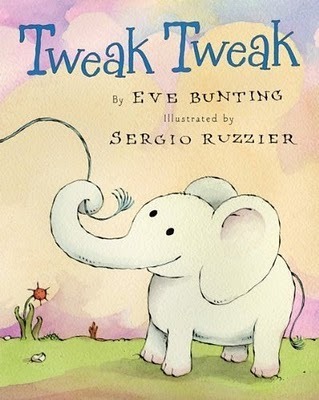

Here's the cover!

Published on October 05, 2010 13:27
Drawn in Brooklyn
Alaya, the beautiful and sweet daughter of John Rocco and Aileen Leijten, was kind enough to pose in front of my originals from The Room of Wonders, Amandina and
Hey, Rabbit!
in the Brooklyn Public Library's Grand Lobby.



Published on October 05, 2010 09:58
October 3, 2010
Drawn in Brooklyn: Process Cases
Here are my three process cases, part of the Brooklyn children's book illustrators show at the Brooklyn Public Library.
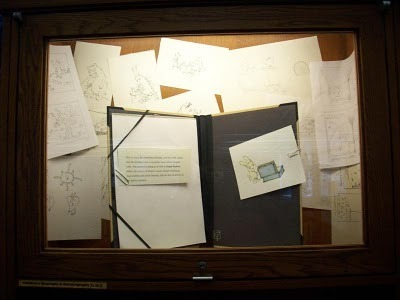
First case: various sketches, a pen&ink and watercolor drawing of Rabbit and an introductory note written by John Marciano, curator of the show (I know, you can't really read it here, sorry!).
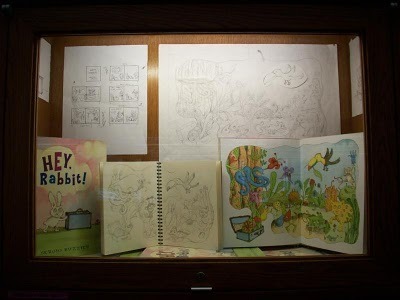 Second case: the evolution of the "rain forest" spread in Hey, Rabbit!, where the toucan finds his leaf. From the thumbnail sketch (top left), to the dummy (front center), to the preparatory pencil drawing (top right) the the printed page. The finished art is in the main exhibition in the Library's main hall.
Second case: the evolution of the "rain forest" spread in Hey, Rabbit!, where the toucan finds his leaf. From the thumbnail sketch (top left), to the dummy (front center), to the preparatory pencil drawing (top right) the the printed page. The finished art is in the main exhibition in the Library's main hall. Third case: one original finished drawing from
Amandina
and two from
The Room of Wonders
.
Third case: one original finished drawing from
Amandina
and two from
The Room of Wonders
.
Published on October 03, 2010 13:02



